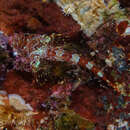Diagnostic Description
provided by Fishbase
Head and body red to reddish brown with pinkish blotches and prominent dark columns and arches running onto belly. Fins of various hues of pink and red. Distinguished from other triplefins by the distinctive color pattern and the continuous lateral line extending to the caudal peduncle.
- Recorder
- Cristina V. Garilao
Morphology
provided by Fishbase
Dorsal spines (total): 18 - 21; Dorsal soft rays (total): 9 - 11; Analspines: 0; Analsoft rays: 20 - 22
- Recorder
- Cristina V. Garilao
Biology
provided by Fishbase
Adults inhabit rock pools and in surge zones, especially in exposed areas. Usually on steep slopes or sides of boulders encrusted with invertebrates and algae (Ref. 13227). Eggs are hemispherical and covered with numerous sticky threads that anchor them in the algae on the nesting sites (Ref. 240). Larvae are planktonic which occur primarily in shallow, nearshore waters (Ref. 94114).
- Recorder
- Cristina V. Garilao
Importance
provided by Fishbase
fisheries: of no interest
- Recorder
- Cristina V. Garilao
Cryptic triplefin: Brief Summary
provided by wikipedia EN
The cryptic triplefin, Cryptichthys jojettae, is a triplefin of the family Tripterygiidae, the only member of the genus Cryptichthys, found around the coast of New Zealand. It length is up to 6 cm. The specific name honours a former staff member at the National Museum of New Zealand, Jorjette Drost, who participated in collecting specimens with Hardy.
- license
- cc-by-sa-3.0
- copyright
- Wikipedia authors and editors

